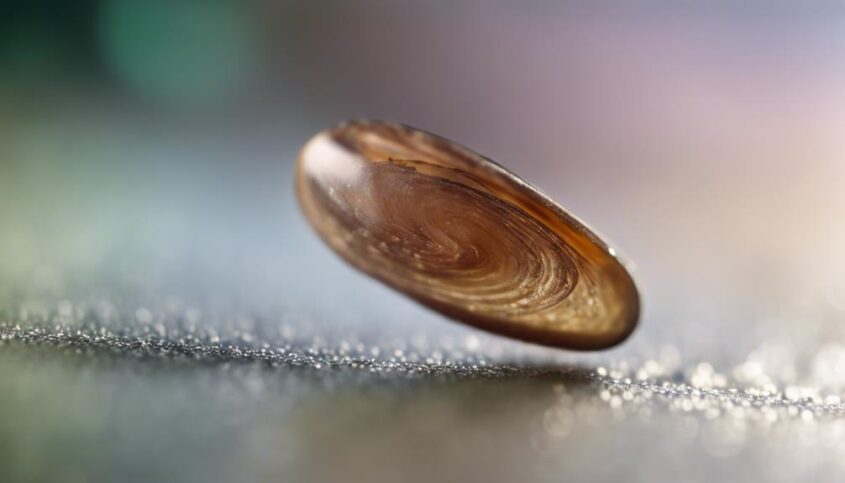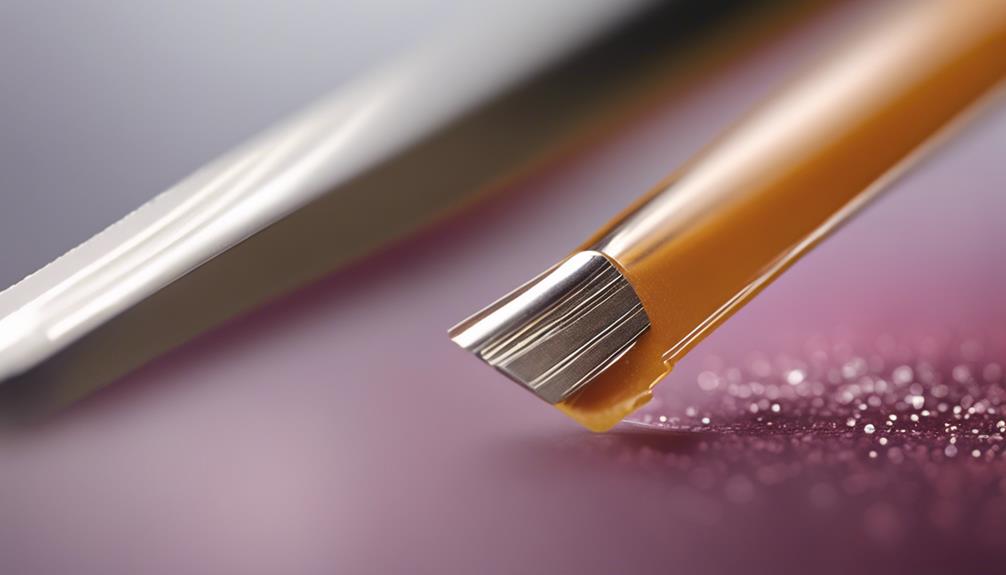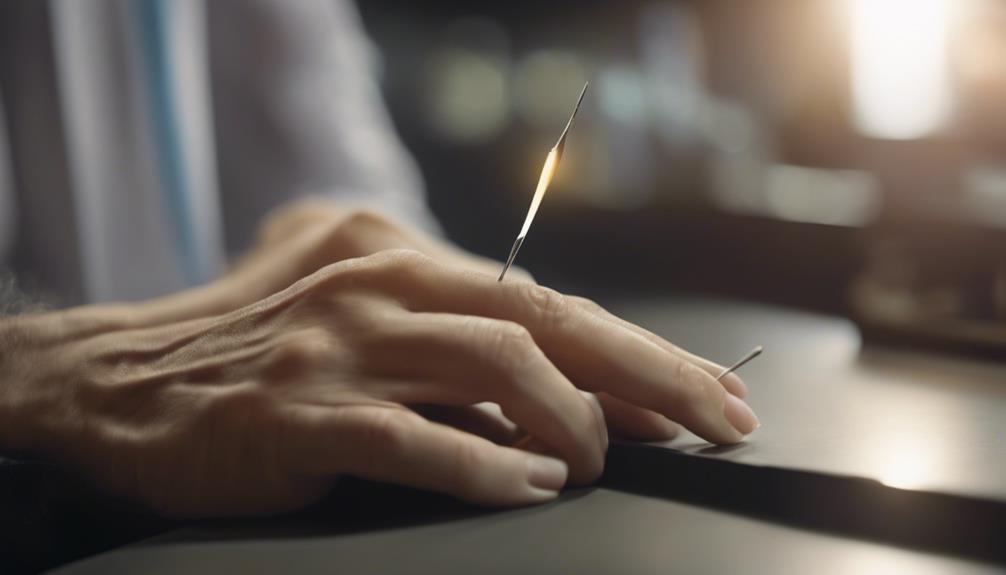What Happens if I File My Nail Too Thin?

Filing your nail too thin weakens its structure, increasing the risk of breakage, infections, and sensitivity. This can impact the overall health and appearance of your nails. It may lead to pain, slow growth, and potential long-term damage. Taking preventative measures like maintaining proper nail care routines and avoiding harmful habits is crucial. Ensuring optimal nail thickness is essential for nail integrity and health. Remember, your nails are more than just a cosmetic feature; they also protect and support your fingertips. Understanding the risks associated with filing nails too thin can help you maintain strong and healthy nails.
Key Takeaways
- Increased vulnerability to breakage, chipping, and infections.
- Loss of natural strength and protection.
- Sensitivity and pain in the nail bed.
- Disruption of the natural growth pattern.
- Higher risk of structural damage and nail weakness.
Nail Thinning Risks

Thinning the nail excessively can lead to a range of potential risks and complications for the nail and surrounding tissue. When the nail plate is filed down too much, it loses its natural strength and protection, making it more susceptible to breakage, chipping, and peeling. This can expose the underlying nail bed to bacteria and fungi, increasing the risk of infections. Moreover, over-filing can cause sensitivity and pain in the nail bed, leading to discomfort and potential inflammation.
Excessive thinning of the nail can also disrupt the natural balance of the nail structure, affecting its growth pattern and overall health. It may result in irregular nail growth, ridges, or distortion of the nail shape. Additionally, repeated over-filing can damage the nail matrix, the area responsible for producing new nail cells, leading to long-term issues such as thin, weak, or discolored nails.
To prevent these risks, it is essential to file the nails gently and only when necessary, avoiding excessive thinning that could compromise the nail's integrity and health.
Structural Damage
When nails are filed too thin, they are prone to structural damage, leading to increased weakness and breakage risk. Structural damage can compromise the integrity of the nail, making it more susceptible to splitting and peeling. Maintaining an optimal nail thickness is crucial in preventing such structural issues.
Nail Weakness
Nail weakness, a common consequence of filing nails too thin, can lead to structural damage and increased susceptibility to breakage. When nails are weakened, they become more prone to various issues that can affect their health and appearance. Here are some key points to consider:
- Brittleness: Weak nails are often brittle and prone to splitting.
- Peeling: Nails may start to peel in layers, making them look uneven.
- Discoloration: Weak nails can show signs of discoloration, indicating underlying problems.
- Slow Growth: Nail growth may slow down due to weakness in the nail structure.
- Sensitivity: Weak nails can become sensitive to touch and external elements.
Taking care to avoid weakening your nails is crucial for maintaining their strength and health.
Breakage Risk
Filing nails too thin can compromise their structural integrity, increasing the risk of breakage and damage. When nails are filed excessively, they become vulnerable to splitting, cracking, and breaking, which can be painful and unsightly. To prevent such issues, it is essential to maintain a proper nail care routine and avoid over-filing. Below is a table illustrating the potential consequences of filing nails too thin:
| Breakage Risk | Consequences |
|---|---|
| Increased | Split nails |
| Heightened | Cracked nails |
| Greater | Breakage |
Pain and Sensitivity
Experiencing pain and sensitivity after filing your nail too thin can be quite common. This can occur due to the damage done to the nail bed, which is rich in nerves and blood vessels. Understanding the healing time required for the nail bed to recover is crucial in managing discomfort and promoting proper nail health.
Nail Bed Damage
As a result of filing your nail too thin, you may notice heightened sensitivity and discomfort in the affected area, indicating potential damage to the nail bed. This discomfort can be concerning, but understanding the implications is crucial for proper care. Here are some key points to consider:
- Increased pain or tenderness when pressure is applied to the nail
- Redness or swelling around the nail bed
- Sensitivity to touch or temperature changes
- Potential development of nail infections
- Delayed nail growth or changes in nail texture
Being aware of these signs can help you address nail bed damage promptly and seek appropriate treatment to promote healing.
Healing Time
After inadvertently filing your nail too thin and experiencing heightened sensitivity and discomfort due to potential damage to the nail bed, understanding the healing time required for pain and sensitivity is essential for proper recovery. The healing process can vary depending on the extent of the damage and individual factors. Here is a general guideline to help you gauge the approximate healing time:
| Healing Stage | Timeframe |
|---|---|
| Initial Recovery | 1-2 weeks |
| Pain Reduction | 2-4 weeks |
| Sensitivity Decrease | 4-6 weeks |
| Full Recovery | 6-8 weeks |
Increased Breakage
Filing your nails too thin can lead to increased breakage, causing frustration and potential damage to the nail bed. When nails are excessively filed, they become weaker and more prone to breaking. This can be a source of distress, especially for individuals who take pride in their nail appearance and health. Here are some key points to consider regarding increased breakage:
- Weakens Nail Structure: Excessive filing weakens the nail structure, making it more susceptible to breakage.
- Risk of Pain: Broken nails can cause discomfort, especially if the breakage occurs close to the nail bed.
- Aesthetics Concerns: Increased breakage can affect the aesthetics of the nails, leading to an uneven and unkempt appearance.
- Impact on Daily Activities: Broken nails can interfere with daily activities, such as typing, opening cans, or performing personal grooming tasks.
- Potential for Further Damage: Continued breakage can potentially lead to more severe damage to the nail bed, requiring professional intervention to repair.
Infection Risk

Excessive thinning of the nails can elevate the risk of bacterial or fungal infections due to compromised nail integrity. When nails are filed too thin, the protective barrier they provide against harmful pathogens is weakened, making it easier for bacteria or fungi to enter and cause infections. Bacterial infections can manifest as redness, swelling, pain, or pus around the nail area, while fungal infections may lead to discoloration, thickening, or crumbling of the nail. Individuals who frequently file their nails too thin are more susceptible to these infections, especially if proper hygiene practices are not followed.
To prevent infection risks associated with filing nails too thin, it is essential to maintain nail thickness within a healthy range. Regularly moisturizing the nails and cuticles, avoiding excessive filing, and using proper nail care tools can help preserve nail strength and reduce the likelihood of infections. If an infection is suspected, seeking prompt medical attention is crucial to prevent complications and promote quick recovery.
Healing and Recovery
Upon realizing the detrimental effects of filing nails too thin, focusing on the healing and recovery process becomes crucial for restoring nail health and strength. Nails that have been filed too thin are fragile and prone to damage, but with proper care and attention, recovery is possible. Here are some essential steps to aid in the healing and recovery of over-filed nails:
- Moisturize Regularly: Hydrating the nails and cuticles with a nourishing moisturizer helps restore moisture and flexibility to the nail plate.
- Avoid Harsh Chemicals: Refrain from using harsh nail products that can further weaken the nails, opting for gentle, nourishing formulas instead.
- Protective Nail Treatments: Utilize strengthening nail treatments or clear coats to provide a protective barrier while the nails heal.
- Maintain a Balanced Diet: Consuming a diet rich in vitamins and minerals supports overall nail health and promotes faster healing.
- Gentle Nail Care: Be gentle when handling nails to prevent further damage and allow them to grow back stronger and healthier.
Prevention Tips

To prevent nail damage and maintain optimal nail health, implementing effective prevention tips is essential. Firstly, it is crucial to keep nails properly trimmed and shaped to prevent them from becoming weak or brittle. Using sharp, high-quality nail clippers or scissors can help avoid unnecessary stress on the nails. Additionally, maintaining a balanced diet rich in vitamins and minerals, such as biotin, vitamin E, and iron, can promote strong and healthy nails.
Furthermore, protecting the nails from harsh chemicals and excessive moisture is vital for their well-being. Wearing gloves while doing household chores or using cleaning products can prevent nails from becoming weak and brittle due to prolonged exposure to chemicals. Moisturizing the nails and cuticles regularly with a nourishing oil or cream can help prevent dryness and cracking.
Lastly, avoiding habits like biting nails or using nails as tools can prevent unnecessary damage. Practicing good nail hygiene, such as keeping nails clean and dry, can also contribute to overall nail health. By following these prevention tips, individuals can help maintain strong, healthy nails and prevent potential damage from occurring.
Frequently Asked Questions
Can Nail Thinning Lead to Permanent Damage?
Nail thinning, if excessive, can potentially lead to permanent damage. It is crucial to practice proper nail care techniques to maintain nail health. Consulting a professional for guidance on filing and maintaining nail thickness is advisable.
How Long Does It Take for a Thin Nail to Heal?
The healing time for a thin nail can vary depending on the extent of damage and individual factors. Typically, nails grow at a rate of about 2-3 millimeters per month, so it may take a few months for a thin nail to fully heal.
Is It Normal to Experience Discoloration After Filing Too Thin?
Like a delicate canvas, nails can show discoloration when filed too thin, often due to trauma. This occurrence, though not uncommon, can be concerning. Seeking professional advice is advisable to understand and address any underlying issues.
Can Filing Nails Too Thin Cause Changes in Nail Shape?
Filing nails too thin can lead to changes in nail shape as it weakens the structural integrity. This alteration can result in fragile, misshapen nails prone to breakage. It's essential to maintain a balanced filing technique for nail health.
Are There Long-Term Consequences of Filing Nails Too Thin?
Filing nails too thin can weaken their structure, leading to increased susceptibility to breakage and infection. Prolonged thinning may result in long-term damage, impacting nail health. It's crucial to file gently and maintain nail integrity.




